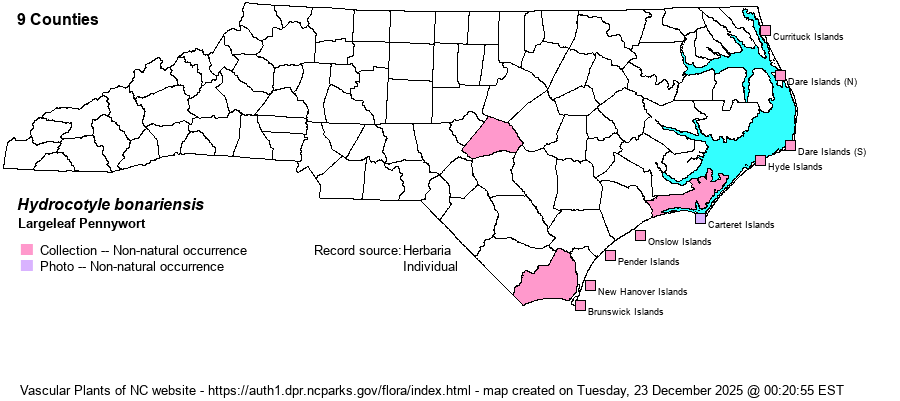| Author | Lamarck | |
| Distribution | Found along the entire coast. Inland records in the Coastal Plain from Greene and Perquimans counties are actually H. tribotrys. The record from Harnett County is not natural (hedgerow at edge of yard and roadside, likely established from plantings). For decades it was considered to be a native species, but Weakley (2025, pers. comm.) now thinks it is most likely an alien. It does not appear in early regional floras (Walter 1788, Elliott 1821, Chapman 1860) and was originally described from Uruguay ("near Buenos Aires"). It occurs widely in S.A. and is considered native there.
This is essentially a coastal species, ranging barely into southeastern VA, and south around the coasts to TX; there are scattered inland records. It occurs rather continuously through Mex., C.A., and S.A. | |
| Abundance | Frequent to common along the coast. | |
| Habitat | This is a characteristic beach dune plant, found around dunes, especially in damp spots such as swales. Away from dunes, it occurs in damp, sandy and open ground. |
| Phenology | Blooms from April to September, and fruits shortly after flowering. | |
| Identification | This is a familiar plant around coastal dunes, sprawling or creeping, with thick and somewhat fleshy leaves, often forming large clumps of plants. Each leaf is on a long petiole, often 3-6 inches long, and the blade is peltate, with the top of the petiole connecting to the middle of the leaf underside. The orbicular blade is about 3 inches across, with scalloped margins. There are numerous umbels of flowers, on stalks of 3-4 inches high, and each cluster is verticillate on the branches (i.e., tiny whorls of flowers at intervals on the branches). H. umbellata, a very numerous wetland species, is similar but has a single, simple umbel on a long stalk, as opposed to numerous whorled ones on branches. Several other species have peltate leaves like this one, but the whorled flowers are on unbranched axes. | |
| Taxonomic Comments | None
| |
| Other Common Name(s) | Dune Pennywort, Seaside Pennywort, Giant Pennywort, Dollarweed. The common name of Largeleaf Marsh-pennywort is used on this website for the also non-native H. bowlesioides. | |
| State Rank | SE | |
| Global Rank | G5 | |
| State Status | | |
| US Status | | |
| USACE-agcp | FACW link |
| USACE-emp | FACW link |

